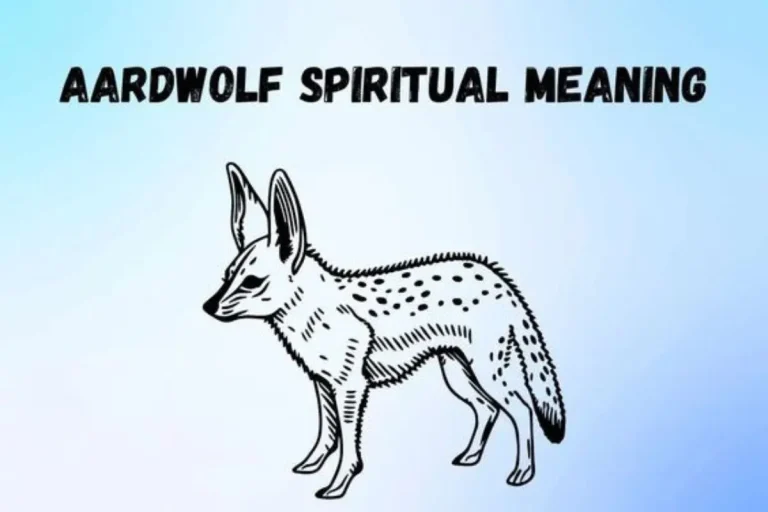Anteater Spiritual Meanings and Symbolism

The anteater is a very special animal. It’s easy to recognize because of its long nose, sharp claws, and its habit of eating mostly ants and termites. These creatures are part of the Pilosa order, which also includes animals like sloths and armadillos.
There are four different kinds of anteaters, and each one has something that makes it unique. The giant anteater is the biggest of them all and can grow up to 7 feet long. It uses its tube-like snout to reach into insect nests, and its sticky tongue helps catch lots of tiny bugs.
Another type is the northern tamandua, which is smaller and likes to climb trees. It spends a lot of time high up in the branches. Then there’s the southern tamandua and the silky anteater, both of which have their own special looks and behaviors.
Even though they’re all different, these animals have something in common—they’re really good at surviving in their own habitats. People have found them interesting for a long time because of how different they are from other animals.

Key Takeaways
- The anteater symbolizes the need for patience, intuition, and a reverent connection to the natural world, embodying principles of adaptability and resilience.
- The anteater’s distinctive features, such as its long snout and powerful claws, represent the ability to seek out and confront hidden truths and challenges.
- As a solitary creature, the anteater encourages introspection, self-discovery, and finding fulfillment from within, rather than relying on external sources.
- In various cultural and spiritual traditions, the anteater is revered for its unwavering dedication, patient approach, and interconnectedness with the cycle of life.
What It Means When You See an Anteater
When you see an anteater, it could mean something deeper than just spotting an animal. Some people believe this moment carries a spiritual message. It may be telling you to slow down, be more patient, and pay closer attention to your thoughts and surroundings.
Anteaters don’t rush. They take their time and rely on their senses to find food and stay safe. In the same way, you might be guided to move carefully and trust your instincts. This could help you avoid problems and reach your goals more calmly.
These animals also like being alone, which can be a sign that you need time to think quietly or focus on your own path. Spending time by yourself isn’t a bad thing—it might help you grow stronger inside.
Seeing an anteater might also remind you to be gentle, even when life gets tough. You don’t always need to push or fight. Sometimes, being kind and soft can be the best way to move forward.
Symbolism of the Anteater
The anteater carries deep symbolic meanings. People often connect it with qualities like patience, strength, and the ability to solve problems in creative ways. These ideas come from how it lives and behaves in the wild.
Its long snout and sticky tongue show how it gets food from places that are hard to reach. This might symbolize the skill of finding answers in tough situations. It encourages you to keep going, even if things don’t come easily.
The anteater’s strong claws can tear into hard ground to find ants. That’s why many believe this animal represents the need to dig deeper when you’re looking for the truth or solving a problem.
Because it often lives and travels alone, the anteater is also linked to quiet thinking and inner peace. It shows that taking time for yourself can lead to personal growth and a better understanding of what matters most.
Lastly, its close bond with nature reminds us to stay connected to the earth. Living simply, respecting nature, and noticing life’s small details can all be part of the anteater’s lesson.
7 Spiritual Meanings of Anteater
The anteater’s unique characteristics and behaviors hold profound spiritual significance. Its patience, adaptability, and deep connection to nature symbolize the power of perseverance, resilience, and harmony with the natural world.
Additionally, the anteater’s symbolic consumption of ants represents our ability to intuitively communicate with and understand the intricate workings of the world around us.
1. Patience and Perseverance
The anteater moves slowly but with purpose. It doesn’t rush or panic, even when faced with a large ant mound. Instead, it uses its strong claws and long snout to dig carefully, one step at a time.
This teaches us that staying calm and focused can help us reach our goals. Life isn’t always about speed—it’s about steady progress. When things get tough, the anteater reminds us to keep going, even if it takes longer than we expected.
In today’s fast world, many people want instant results. But real success often takes time, effort, and patience. The anteater shows that staying committed matters more than finishing fast.
Whether we are studying, working, or dealing with personal struggles, this animal encourages us to trust the process. Keep showing up, one small action at a time, and you’ll get there.
2. Intuitive Communication
The anteater doesn’t use loud sounds or big movements. Instead, it relies on its senses to move through the world. Its body picks up small vibrations in the earth, helping it find food and stay safe.
This kind of silent communication reminds us to pay attention to what isn’t said out loud. Sometimes, feelings and energy speak louder than words. The anteater encourages us to notice these quiet signs.
Its soft and careful movements show that not all actions need to be bold. Small, graceful steps can carry great meaning. We don’t always need to talk to understand or connect with others.
By watching how the anteater behaves, we learn the value of listening—not just with our ears, but with our hearts and senses. That awareness can help us grow in both relationships and spiritual understanding.
3. Adaptability and Resilience
Anteaters can live in forests, grasslands, or even dry areas. They survive in many places because their bodies are made to adjust. Their snout, tongue, and claws help them find food in different environments.
This ability to adapt is important in life. Things don’t always go as planned, and sometimes we must change direction. The anteater shows that it’s possible to stay strong, even when life shifts around us.
When predators or dangers appear, the anteater doesn’t panic. It uses its sharp claws to protect itself and moves on when it needs to. This is a lesson in bouncing back from hard times.
By learning from this animal, we can develop the strength to handle changes and challenges. We don’t have to be perfect. We just need to be flexible, keep learning, and stay steady.
4. Connection to Nature
The anteater is closely tied to its natural world. It lives quietly, blends into its surroundings, and follows the rhythms of day and night. This deep link with nature is something we can also build in our own lives.
It uses its claws and snout to find food hidden in the earth. This shows how every living thing plays a part in the ecosystem. The anteater doesn’t take more than it needs—it works in balance with the world around it.
Its quiet life reminds us that we don’t always need noise or crowds. Sometimes, the most powerful growth happens in silence, when we are alone and observing the world around us.
As habitats change and people move into wild spaces, the anteater continues to adjust and survive. It tells us to stay connected to nature, no matter where we are, and to protect the earth we all share.
5. Symbolic Ant Consumption
The anteater spends most of its time searching for ants. It’s patient, focused, and determined. To it, each tiny ant is part of something bigger. This behavior teaches us about dedication and focus.
It doesn’t give up if one nest is empty. It keeps looking, searching, and working toward its goal. That kind of mindset helps us tackle small problems in our own lives with the same steady attention.
Each ant it eats can be seen as a challenge we overcome. No matter how small the problem, when we face it with care and determination, we grow stronger and wiser.
By watching the anteater, we’re reminded that the little things in life matter. Paying attention to details and staying focused—even when progress feels slow—can lead to great results.
6. Grounded Spirituality
While some animals are known for high-speed or flashy skills, the anteater shows a different kind of strength. Its focus is simple: find food, stay safe, and keep moving. This brings a sense of grounded spirituality.
It doesn’t waste energy chasing things it doesn’t need. Instead, it follows its path with purpose. That teaches us to focus on what truly matters and not get distracted by things that aren’t helpful.
When life feels busy or overwhelming, thinking like an anteater can help. Stay calm, keep working, and don’t overcomplicate things. Simple actions, done with care, can be very powerful.
This animal also shows us how to use the tools we have. Its long tongue and claws are perfect for its needs. We too can learn to use our own talents and strengths to handle life’s challenges in smart and peaceful ways.
7. Unique Perspective
The anteater looks different from most animals. Its long nose, bushy tail, and strong claws make it stand out. But these traits are exactly what help it succeed. That’s a powerful message for anyone who feels different.
It reminds us that being unique is a strength, not a weakness. What makes you stand out might be the very thing that helps you grow and shine in your spiritual path.
Its quiet, focused behavior teaches that you don’t have to follow the crowd. You can walk your own path, in your own time, and still make a big impact.
Whether it’s its patience, toughness, or sharp senses, the anteater shows that having a fresh outlook can help us discover new ways of thinking, feeling, and growing in our lives.
Anteater Symbolism in Different Cultures and Contexts
The anteater isn’t your typical animal when it comes to symbolism. Across many cultures, it stands out because of its unusual shape, slow movements, and quiet strength. People from different parts of the world have connected the anteater’s qualities with deep meanings that reflect spiritual lessons and life values.
Its strange yet fascinating features—like its long snout and slow, careful steps—have led many to think of it as a symbol of wisdom and calm power. In some traditions, this creature is even seen as a kind of teacher. Each culture adds its own unique meaning to the anteater, making it a powerful symbol worldwide.
Let’s break down how the anteater shows up in Native American, Celtic, Nordic, African, Eastern, and Hindu traditions. We’ll also look at its role in arts, dreams, spiritual beliefs, and even how it’s seen as a spirit animal.
Native American Culture
In Native American traditions, the anteater is viewed with great respect. It often stands for wisdom, patience, and a strong bond with the earth. This comes from the way it moves—slow and steady—and the way it finds food carefully and thoughtfully.
The anteater’s long tongue is more than a physical trait. It’s often seen as a symbol of curiosity and a never-ending search for knowledge. People admire how it uses its tongue to find hidden insects, seeing it as a sign of someone who digs deep for truth.
Its methodical style of searching is also important. Many tribes see it as an example of how to move through life—with focus, care, and mindfulness. This creature doesn’t rush, and that’s a lesson many Native stories try to teach.
Some myths even describe the anteater as a spiritual guide. It shows up in stories as a creature that teaches people to stay humble, work hard, and stay connected to the land around them.
Celtic Culture
In Celtic beliefs, the anteater holds different but equally meaningful symbolism. It is connected to digging deep, not just into the soil, but into the self. People who follow Celtic traditions may see the anteater as a reminder to search inside for hidden truths.
Its ability to dig is more than physical—it points to an emotional and spiritual task. It stands for the journey of self-discovery, where one must face challenges and keep going, even when it’s hard. This links closely to Celtic views on personal transformation.
The anteater’s solitary behavior also matters. In Celtic thinking, being alone isn’t bad—it’s a time for reflection. The anteater, in this sense, becomes a symbol of introspection and taking time to think before acting.
Its connection to nature is strong, too. Because it stays so close to the ground and depends on the cycles of life, it teaches about being grounded and in tune with natural rhythms. These ideas are important in many Celtic rituals and teachings.
Nordic Culture
In Nordic culture, the anteater is seen as a strong survivor. The focus here is on its ability to handle rough conditions and make the most out of what it has. People from Nordic regions admire animals that can thrive in tough environments, and the anteater fits that role well.
Stories from these areas may show the anteater as a forest guardian, using its sharp senses to find its way through thick woods and icy terrain. Some legends say it helps guide lost travelers, pointing to its reputation as a creature of insight.
The anteater’s claws and snout are symbols of survival tools. It uses them to break through hard soil, find food, and stay safe. These traits are linked to important Nordic values like self-reliance and courage.
Living in harmony with a cold and difficult land takes more than strength—it takes smart thinking. The anteater, in Nordic symbolism, represents resourcefulness, which is key to living a strong and independent life.
African Culture
In Africa, the anteater shows up in stories and beliefs that celebrate resilience and clever thinking. Each region highlights different traits, but the main idea is the same: the anteater survives by being smart, patient, and aware of its environment.
In Zulu culture, the anteater is known for perseverance and strength. It teaches people to keep going, even when life throws challenges their way. In Yoruba belief, it’s more about wisdom and thriving, no matter the situation.
The Dogon people of Mali focus on the anteater’s ability to adapt, while the Akan in Ghana view it as a symbol of self-sufficiency. Each of these views connects to the way the anteater uses its unique skills to survive.
In the Kongo culture, the anteater stands for cleverness and doing things in new, unexpected ways. Instead of brute force, it uses strategy—something many African folktales celebrate.
Eastern Culture
In parts of Asia, especially where traditional philosophies like Taoism and Buddhism are practiced, the anteater is a symbol of calm progress and balance. It’s not a flashy animal, but its slow and steady nature carries a big message.
People admire the anteater’s patience when hunting. In many Eastern traditions, patience is a spiritual strength. Taking time, moving carefully, and focusing on each step are seen as parts of a wise life.
The anteater’s deep connection to the earth ties into the idea of living in harmony with nature. This is a major theme in many Eastern teachings, where people are encouraged to live with the flow of the world around them.
Because it adapts well to its surroundings, the anteater also represents flexibility. Being able to shift and change, without losing your core self, is seen as a path to peace and happiness.
Hindu Culture
In Hindu beliefs, the anteater takes on a special role. It shows patience, hard work, and a peaceful way of living. The way it works slowly but surely for its food is a lesson in spiritual dedication.
Hindus also see a link between the anteater and ahimsa, the idea of non-violence. The anteater eats ants without destroying everything in its path. It’s a quiet hunter, not a destructive one.
This behavior reflects the Hindu value of living gently, even while trying to meet one’s needs. The anteater, then, becomes a symbol of harmony and respect for all life.
Its look is also important. The long nose and unique body shape are often used in Hindu art as signs of spiritual depth and mystery. These images remind people to see the beauty in every living being.
Arts and Literature
The anteater hasn’t stayed locked in religious stories—it appears in all kinds of art. From ancient drawings to modern books, artists are drawn to its strange shape and powerful meanings.
In Latin America, the anteater shows up in folklore as a wise and strong creature. It’s often used to talk about uncovering secrets or standing firm when times get tough. Murals, carvings, and weavings celebrate its form.
Children’s books love the anteater, too. Its quirky nose and quiet habits make it perfect for stories that teach kids about being unique and thoughtful. It often becomes a character who solves problems slowly but smartly.
Surreal artists use the anteater to talk about dreams and hidden ideas. Its odd shape makes it perfect for exploring deep emotions or subconscious thoughts in paintings or poems.
Modern writers often turn to the anteater when they want to explore themes like survival, change, and the need to look deeper. It reminds people to keep searching, even when answers aren’t easy to find.
Mythology
In ancient myths, the anteater pops up with powerful meaning. Some cultures saw it as a creature of the earth, others tied it to life after death. Its digging behavior often connects it to deep spiritual ideas.
In Mayan stories, the anteater is linked to fertility and the earth. It represents digging into the ground to bring out life. The Aztecs thought the anteater had ties to the underworld, guiding souls through darkness.
Native American stories speak of the anteater’s ability to move through tough places. With its strong body and sharp claws, it becomes a helper on spiritual journeys or a guide in hard times.
These stories show that the anteater is more than an animal—it’s a bridge between worlds, a sign of mystery and power that stretches across time and belief systems.
Biblical Meanings of Anteater
Though the Bible doesn’t mention anteaters directly, some people have drawn spiritual meanings from its traits. They believe the anteater stands for discernment, the ability to tell right from wrong.
Its long, sticky tongue could be seen as a symbol of finding what’s hidden. It reaches into places others can’t, which matches the idea of searching for truth with care and precision.
Its quiet, solitary way of life reminds some of the biblical path of meditation, withdrawal, and spiritual growth. Being alone is sometimes necessary to hear God’s voice and reflect on life’s purpose.
Its strength and ability to keep going, even in tough environments, can be a symbol for the faith journey—full of challenges, but leading to growth and clarity.
Dream Interpretations of Anteaters
When you see an anteater in a dream, it might mean you’re going through a time of deep reflection. This animal often appears when you need to think carefully about something in your life.
Its digging can show that you’re ready to uncover hidden truths—maybe about yourself, or something around you. It’s a sign to look beneath the surface.
The anteater may also represent your determination. You might be facing a hard situation, but this dream reminds you to keep working through it slowly and carefully.
And if the anteater seems calm and peaceful, it may mean that you’re being called to live more in balance with nature and your inner self.
Spirit Animal, Totem, and Power Animal
As a spirit animal, the anteater shows you how to solve problems in a careful, thoughtful way. It tells you that strength isn’t always loud—it can be quiet, steady, and smart.
Its claws and tongue represent tools. These tools help you look at problems from every side. The anteater reminds you that patience and persistence are often the keys to success.
If the anteater is your totem, it may mean you’re someone who listens to your gut feelings. You trust your instincts, and you take time before jumping into action.
Its presence in your life is a gentle push to keep learning, stay strong, and use your unique gifts to move through challenges—one step at a time.
Final Thoughts
The anteater carries powerful meaning across cultures and beliefs. People admire it not for speed or flash, but for its quiet wisdom, strength, and ability to move through life with care.
Whether in stories, art, or dreams, this animal reminds us to stay focused, dig deep, and respect the natural world. It teaches that success often comes slowly, and that being different can be a real strength.
You Might Also Like
1) Black Panther Spiritual Meanings and Symbolism
2) 7 Spiritual Meanings of Alligator and Its Symbolism
3) Spiritual Meanings of Ant and Its Symbolism
4) Xerus Spiritual Meanings and Symbolism
5) Woodchuck Spiritual Meanings and Symbolism
6) Hedgehog Spiritual Meanings and Symbolism





